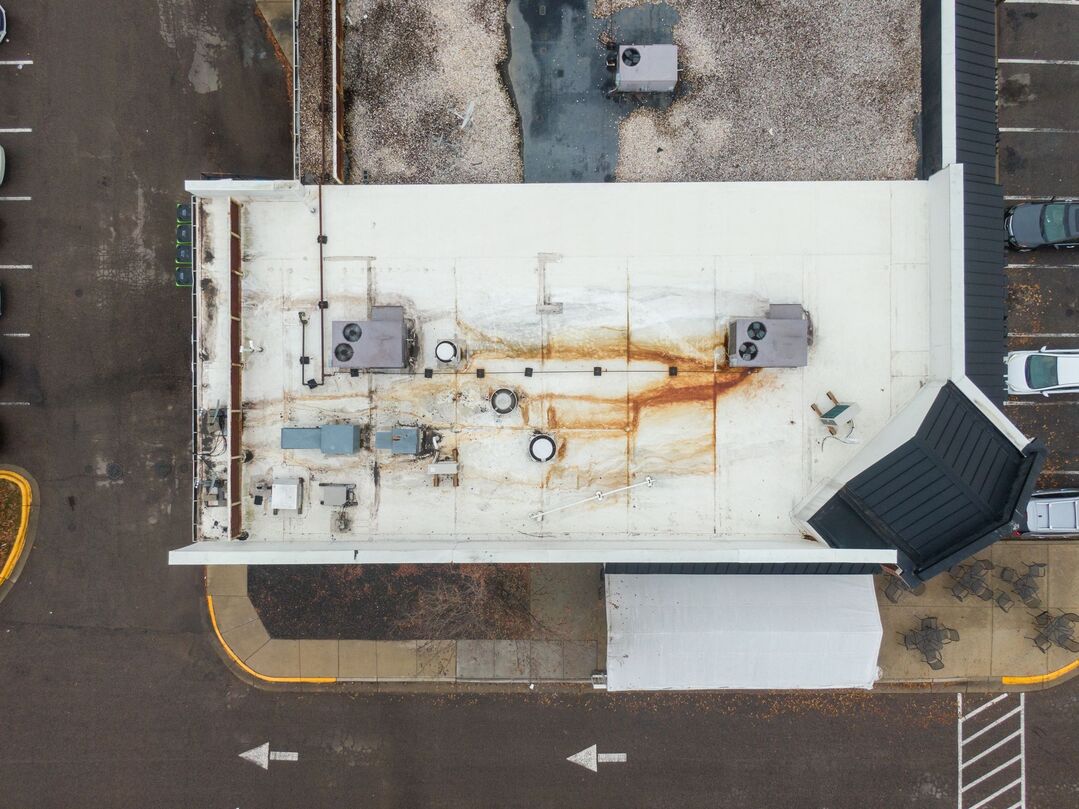Why Most Commercial Roof Insurance Claims Are Underpaid — And What You Can Do About It

When a commercial property suffers roof damage, the insurance claim process can be overwhelming. Many building owners and contractors expect their policy to cover all necessary repairs, only to find the claim payout falls short. This is often not due to malice or error, but rather the complexities of commercial roofing systems, policy language, and high-volume claim handling, especially after severe weather events.
Let’s explore why commercial roof damage claims are frequently underpaid and what you can do to get a fair outcome.
Underpaid Commercial Roof Damage Claims Could Financially Burden Businesses and Repair Contractors
An underpaid roof insurance claim occurs when the settlement amount doesn’t fully cover the true cost of restoring the roof to its pre-loss condition. For property owners, this can mean unexpected out-of-pocket costs. For contractors, it may mean absorbing costs or facing project delays while negotiating supplements.
In commercial settings, like apartment complexes, offices, or retail buildings, these gaps in coverage can represent tens or even hundreds of thousands of dollars.
Why Are Commercial Roof Damage Claims Often Underpaid?
1. Insurer Procedures: Depreciation, Exclusions, and Claims Volume
Insurance companies typically calculate claims using Actual Cash Value (ACV), which accounts for depreciation, especially for older or rental properties. While some policies may eventually pay Replacement Cost Value (RCV), many commercial policies are written differently than residential ones, with different coverages and endorsements.
Certain damage might be labeled as “wear and tear” or routine maintenance, which is commonly excluded unless specifically covered by an endorsement. Add in the reality of increasing claim volumes due to climate-related events, and it’s easy to see how estimators—working quickly and within policy limits—might not capture the full scope of damage.
2. Rushed or Incomplete Inspections
After major storms, insurance will occasionally send field adjusters from out of state to work temporarily in heavily affected areas. Single field adjusters are not typically in town longer than a few weeks and have little time to become familiar with the local code requirements.
Even though field adjusters can utilize readily available technology like drones or ladder assists to work more efficiently, such technology and their limited experience with local code requirements can precipitate rushed inspections that do not reveal latent damage or incorrectly treat code-related requirements.
3. Complex Roofing Systems and Hidden Damage
Unlike a simple shingle roof, commercial roofs are often multi-layered with insulation, mechanical units, HVAC systems, and membranes like TPO or EPDM. Water damage can hide beneath these layers, invisible without thermal imaging or invasive testing. When these complexities aren’t fully accounted for, the repair estimate is often far below actual costs.
The Insurance Playbook: Why Policies Are Denied or Pay Out Less

There are consistent patterns in underpaid or denied claims:
- Roofs are sometimes denied based on “age” rather than observable damage.
- Damage is categorized as pre-existing wear rather than storm-related.
- Code-required upgrades (like decking or insulation) may be left out entirely.
- Some estimates simply miss entire sections of damage.
Helpful Insight: Wondering what not to say to an adjuster? Avoid making assumptions about the cause or age of the damage—stick to facts and documentation, and let your trusted supplement partner, Claim Supplement Pro, do the heavy lifting of building a strong supplement and communicating with insurance.
How to Determine if Your Roof Claim Was Underpaid
Watch for these red flags:
- The insurer provides a lump sum without a detailed breakdown.
- There’s no mention of code upgrades or permitting costs.
- Quantities of materials appear low or incorrect.
- If the cost of the material order is much higher than the insurance estimate.
A useful tool is the “break-even point.” For example, if your roofing system costs $5.05 per square foot or more and the insurer’s estimate is below that, it may be a signal to submit a supplement.
How to Recover Lost Dollar Amounts After an Underpaid Claim

1. Request a Reinspection
A reinspection allows for a second look, often with better context and documentation. Be sure to provide clear, labeled photos of the damaged slopes, elevation views, and interior signs of leaks.
2. Make a Counter Estimate
When a contractor contests the estimate of the insurance company, they’re essentially providing their professional opinion as to what the repair work costs. Many contractors draft their own rough or lump-sum estimates based on their rates, but as we’ve learned by reading these estimates, their bids still come in lower than correct, mainly because these contractors do not have access to Xactimate’s market-based prices.
Xactimate is a powerful, yet expensive and sophisticated estimating program; most contractors do not own a copy or utilize it effectively. This is where Claim Supplement Pro makes a difference. Our experts create thorough, code-compliant, and professionally prepared Xactimate estimates that accurately reflect the actual repair cost.
3. Hire a Supplement Specialist to Maximize the Claim
At Claim Supplement Pro, we specialize in helping contractors and owners identify missed damage and submit detailed supplements. We handle the heavy lifting—from building the estimate to referencing code and policy—so you can focus on completing the job.
How Do You Fight a Roof Insurance Claim?
Start by reviewing your policy in detail so you understand what’s covered. Then, gather thorough documentation of the damage, including dated photos showing damage, storm records, and a measurement report.
Most importantly, work with a supplement specialist, Claim Supplement Pro, who can identify underpaid items, build a professional estimate using Xactimate, and help you submit a strong, well-supported supplement.
Should You File a Claim? Here’s When It Makes Sense
As a contractor, you play the crucial role of being your property owner’s partner. Knowing when to file for a roof claim is as important as ensuring the claim gets approved and funded. Your experience and guidance help property owners make smart, timely decisions, not emotional or risky ones.
Filing an unnecessary claim can negatively impact the property owner’s insurance policy, but on the other hand, missing out on a valid claim could cost your customer thousands in uncovered repairs.
So, how do you help them decide?
This depends on two key factors:
- If the damage is minor and less than the deductible, that would be a valid reason NOT to file a claim, since insurance will not pay anything.
- If damage is clearly storm-related and not just wear and tear or maintenance, then that’s a good sign to file a claim. Storms are typically insured events, so determining this is key to knowing if it’s worthwhile to move forward with a claims process.
For minor cosmetic issues, it may not be worth the risk of filing. But for larger damage — especially from hail, wind, or falling debris — a thorough inspection and a second opinion can make all the difference in catching covered damage early and ensuring the claim is filed properly.
Real Case Examples: What an Underpaid Claim Looks Like (and How It Was Fixed)
- Before: A 13,000 sq ft bitumen roof was approved for $ 120,000.00. The insurer missed insulation, HVAC curb flashing, and local code-required systems.
- After Supplement: With proper documentation and support, the revised claim totaled $300,000.00, allowing the project to be completed with quality materials and no out-of-pocket expense for the building owner.
How Claim Supplement Pro Can Help You Recover What You Deserve
We partner with contractors and adjusters:
- Review estimates and identify missing items
- Build accurate scopes using Xactimate
- Document code requirements and manufacturer specifications
- Maximize approved claim amounts
Final Thoughts: Don’t Settle for Less on Your Roof Claim
Underpaid claims aren’t unusual, but they don’t have to be the final word. With the right team, it’s possible to recover the true cost of repairs and ensure your property is restored the right way.
At Claim Supplement Pro, we don’t just write estimates — we fight for accuracy, fairness, and full value. Our team works closely with contractors and adjusters to recover missing dollars in underpaid roof insurance claims.
We understand the policy language. We know how to document code upgrades. We use Xactimate and industry best practices to ensure every line item is supported and justified.
Don’t wait until the claim is closed or the job is losing money.
Schedule your free consultation today. Let Claim Supplement Pro Help You Maximize Your Roof Claim — We’ll show you exactly what was missed and how we can recover it.


